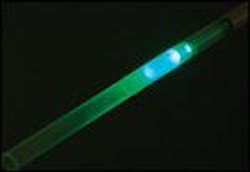Researchers at Ohio State University (Columbus, OH) and the University of Utah (Salt Lake City, UT) have observed photoinduced magnetism in an organic material, manganese tetracyanoethylene. Polycrystalline samples of the material were applied to adhesive tape for measurements of alternating-current magnetic susceptibility or dispersed in transparent mineral oil and sealed in a quartz capsule, as shown, for direct-current magnetization measurements.
The samples were illuminated either by argon-ion laser light or by a halogen lamp with interference filters. Excitation by laser light in the 2.54- to 3.0-eV laser band increased the magnetism of the material, while light from the 1.8- to 2.5-eV band decreased it (see figure). The experiments were performed below 75 K, at which temperature the material exhibits magnetic susceptibility.1
"We measured the magnetism in the magnetic state, and then we shined a blue light on the sample and the magnetism increased by about 60%," said Arthur Epstein, a professor in the departments of physics and chemistry at Ohio State. "Then we shined a green light on the sample and the magnetism decreased by about 60% of what it gained."
Epstein described the work as a new class of experiments, looking at the effect of light not just on magnetism but also on susceptibility, or the speed at which magnetism changes within the material when a magnetic field is applied. "We didn't just look at the magnetism," he said. "We looked at the effect of the magnetic field on the magnetism, and then we looked at the effect of light on the effect of the magnetic field on magnetism. That required setting up a whole new set of experiments." Instead of simply using a magnetometer to measure the effects of a direct-current magnetic field, the researchers had to also apply a time-varying magnetic field at 10, 100, or 1000 Hz and measure the effects on the sample of illumination delivered via fiberoptics.
Potential applications of photoinduced magnetism in polymers include magneto-optical information storage that allows writing as well as reading. They also include information-processing tasks. "You could write on the system, maintain the magnetism, and then erase it when you want," Epstein said. By using light to modulate magnetism, one might also modulate signals passing through the medium, he added.
Currently, the researchers are looking into methods for simultaneous exposure of large material samples, and they are exploring chemical methods of increasing the temperatures at which the materials respond, eventually up to room temperature.
"This is the consonance of two very different themes," Epstein said. "One is the effect of light on electronic structure of organic materials. The other is the presence of magnetism in organic materials. This new phenomenon only occurs when you bring both of those things together."
Magnets that were used before 1985 were all made of transition metals and rare earths, he said. The initial organic magnets all had ordering temperatures near absolute zero. Currently more than 25 families of magnets are based on organics and some have ordering temperatures above the boiling point of water. "Now there is another phenomenon," he said. "You can shine light on these organic-based magnets to control their magnetism. That's pretty exciting to me."
REFERENCE
1. D. A. Pejakovic et al., Phys. Rev. Lett. 88(5), 057202-1/4 (Feb. 4, 2002).
About the Author
Hassaun A. Jones-Bey
Senior Editor and Freelance Writer
Hassaun A. Jones-Bey was a senior editor and then freelance writer for Laser Focus World.
